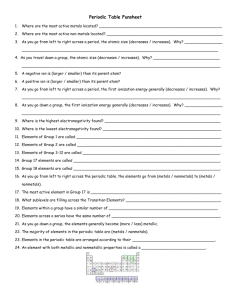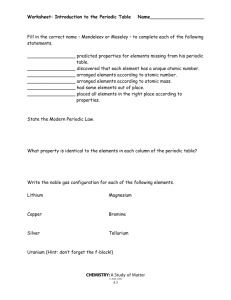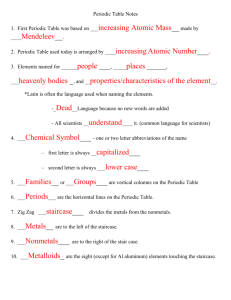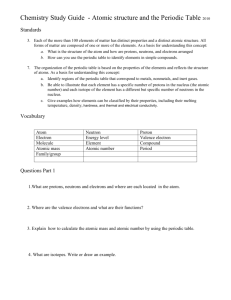11/13 Periodic Table Notes
advertisement
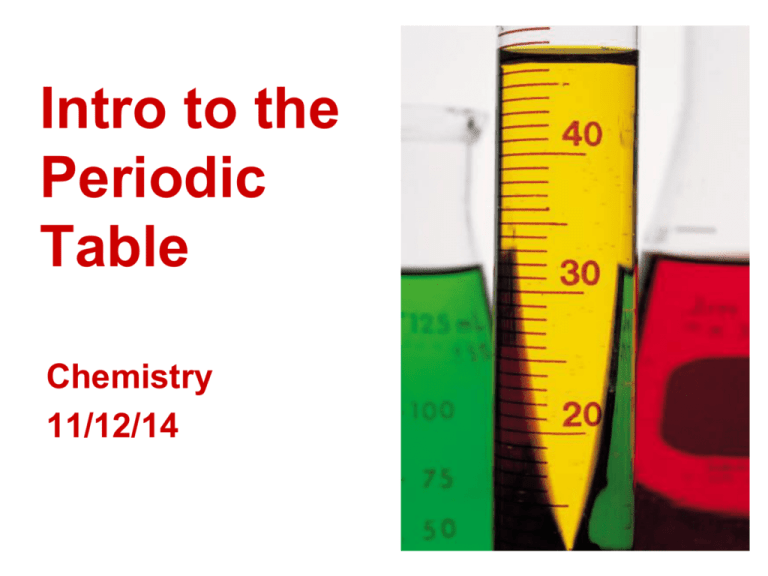
Intro to the Periodic Table Chemistry 11/12/14 Drill • What element is in this Period and Family – 5, 5 – 3, 12 – 1, 1 – 2, 18 • HW: Finish (if needed) – Family Resemblance WS – 5-2 Review & Reinforcement WS Objectives • SWBAT – Name the parts of the Periodic Table. – Differentiate between metals, nonmetals, and metalloids. HW Review • Let’s take a look at – 5-2 Review & Reinforcement WS Mendeleev, Periodic Law, Moseley, and all that jazz History of the Periodic Table • J. W. Dobereiner - 1817 – Elements can be organized in sets of three: • Triads – Ex. Li, Na, K; Cl, Br, I • Average atomic masses in the middle • J. A. R. Newlands - 1865 – Every eight elements, there are similar properties: • Octaves – Ex. Li, Na, K Dmitri Mendeleev, Father of the Modern Periodic Table - 1869 • Dmitri Mendeleev used information about known elements to build the first periodic table. • He used: – Atomic mass – Chemical properties – Physical properties • Notice: – Increasing atomic mass in columns – Similar properties in rows – Missing elements marked with ? • First to propose elements not yet discovered! – Co & Ni – Masses do NOT go in order! Henry Moseley’s Contribution • Henry Moseley made the next great leap forward with the idea of arranging by atomic number. • This fixed the few problems there had been with Mendeleev’s table. • Thanks to Mendeleev and Moseley, we now have the Periodic Law: – When elements are arranged in order of increasing atomic number, there is a periodic repetition of their properties. – That is, you have an element with certain properties. Then, later in the Periodic Table, you have another one with similar properties. (NOT identical, but similar!) Examples of Periodic Trends • Atomic radius, electronegativity, ionization energy • Similarities in reactivity – Noble gases don’t react! (Not with much, anyway) – O reacts with H to make H2O, S reacts with H to make H2S, Se reacts with H to make H2Se, and so on! • Electron configurations: – O: [He] 2s2 2p4 – S: [Ne] 3s2 3p4 – Se: [Ar] 4s2 3d10 4p4 Periodic Properties Atomic Radius Increases Metallic Properties Increase Atomic Number Increases Electronegativity Increases Ionization Energy Increases • Atomic radius of atom gets larger down a family • Each period has one more energy level (shell) making each atom bigger. • Atomic radius measures the size of the atom. • Ionization Energy - The energy required to remove the most loosely held electron from the outer level of an atom in the gas phase. – H + ionization energy H+ + e• The nucleus has + charge, attracting surrounding negative valence electrons. • Electrons farther from nucleus are easier to remove. Thus, big atoms have low ionization energy. • Electronegativity: How tightly an atom holds its electrons Small atom has high IE. Large atom has low IE Ions • Cations: positively charged ions – remember t = + (positive) – Would a cation have a larger or smaller atomic radius than an uncharged atom? • Anions: negatively charged ions – remember aNions are Negative – Would an anion have a larger or smaller atomic radius than an uncharged atom? Metals vs. Nonmetals • The Periodic Table is divided into three major categories: – Metals – Nonmetals – Metalloids (Semi-Metals) Metals, Nonmetals, and Metalloids Blue – Metals Yellow – Nonmetals Pink - Metalloids Metals • Metals are generally to the left and the bottom of the periodic table. • They conduct heat and electricity well. – Ex. Ag, Au, Cu • They are lustrous, malleable, and ductile. – Lustrous – shiny, reflect light – Malleable – may be pounded into sheets – Ductile – may be drawn into wires • They are usually silver-colored (except Au, Cu, Cs) http://www.ndt-ed.org/EducationResources/CommunityCollege/Materials/Graphics/MixedMetals(mayFranInt.).jpe Nonmetals • Nonmetals are to the right and top of the periodic table. • They do NOT conduct heat or electricity well. They are brittle (if solid). • Many are gases, but some are solids. One liquid – bromine! • Many colors – yellow, black, red, green, etc. Metalloids • Metalloids are between the metals and nonmetals. • They behave somewhat like a metal, and somewhat like a nonmetal. • They are somewhat shiny, conduct electricity moderately, and may be slightly malleable. • Some consider hydrogen to be a metalloid; some say they are all solid, so it’s a nonmetal. • Also called semi-metals. http://media-1.web.britannica.com/eb-media/75/131175-004- More info. about Elements • MOST elements: – are solid – are metallic – form compounds with oxygen – are groups of single atoms (monatomic) in their elemental state • A few elemental liquids: – Br2 and Hg – Cs and Ga become liquid at just above room temp More Element Information • Eleven elemental gases: – H2, He, N2, O2, F2, Ne, Cl2, Ar, Kr, Xe, Rn • Seven elements occur in pairs of atoms (diatomic) in their elemental state: – – – – – – – H2 N2 O2 F2 Cl2 Br2 I2 Alternate Periodic Tables No, the one on the wall isn’t the ONLY way to organize it! Alternate Periodic Table #1 One alternate Periodic Table puts the elements in a spiral, with “arms” for the transition metals and inner transition metals: Alternate Periodic Table #2 • This one, called the Tarantola Periodic Table (after the inventor) makes the s block, p block, d block, and f block the most prominent features. Alternate Periodic Table #3 This one, the triangle Periodic Table, uses another organizational system to show relationships: John Dalton’s List of Elements & Symbols The Alexander Periodic Table And two more, for fun… The Table of Rejected Elements Wrap-up • Imagine you have just discovered a stable isotope of element 118 on Jupiter. • What noble gas configuration would it have? • What properties should it have? Why?

